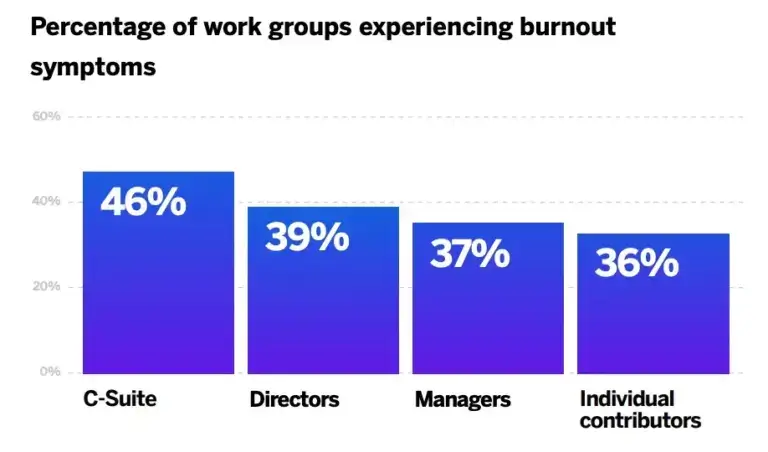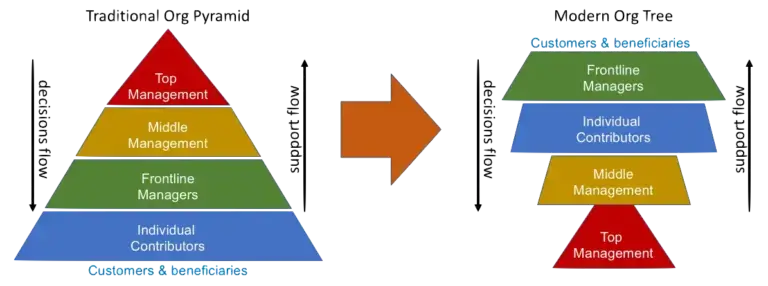In this article, we’ll take a look at the key elements of high performance management and why your organization should establish high performance management. Then, we’ll look at the powerful tech available for your high performance management systems that will help you make the best, data-driven decisions.
Teams need to work at their absolute best for your organization to remain competitive and profitable, and therein lies the challenge – creating a workplace where teams can do just that.
Currently, 2 in 10 employees say that their performance is managed in a way that motivates them to do outstanding work. That leaves a jaw-dropping 8 in 10 employees who are having less-than-motivating performance management. And only 14% of employees who have performance reviews agree that they inspire them to improve their work. Clearly there’s a huge experience gap that needs addressing.
The key people who need to be addressing this are leaders and managers. And it requires something of a rethink – to move away from merely leading and managing employees, and instead coach and develop them as well-rounded people.
When managers and leaders focus on improving the performance of teams through coaching, enablement, activation, and strategic partnerships, it becomes significantly easier to realise business growth.
But there’s more. At the same time, managers and leaders must also make efforts to understand their workforce to see what drives them to deliver 100%. What makes them happy? What makes them fulfilled?
Our 2023 EX Trends report found, for example, that overworked employees are now pushing back against their organizations to set healthy boundaries between work and home. By taking this approach, they are able to achieve a better work-life balance (Good for employees). And of those who feel that they have that good work-life balance, almost two-thirds (63%) are then willing to go above and beyond for their organization (Good for the employer).
Balancing the best employee experience with the best organizational outcomes: this is what high performance management is about.
Free eBook: 2025 employee experience trends report
Defining high performance management
High performance management is a systematic and strategic approach for developing an organization’s workforce – connecting employees to wider processes (such as hiring, business strategy, quarterly goals) – with the aim of achieving exceptional operational results, and then being able to sustain that excellence.
This kind of management is relatively new, though. Traditionally, management has been of the ‘top down’ variety:
- Powerful leaders – who may be unapproachable and intimidating – commanding ‘respect’ by their seniority and long service, dictating business goals
- Individual managers, tasked with delivering those business goals, with their own style of control and regulation (and tending to get the credit for organizational success)
- Employees have to do as they are told by their managers, who they support to deliver business goals to the leaders (and tend to do all the work)
A traditional performance management style often falters because top leadership may feel their goals get diluted and ‘lost in translation’ as they come down the chain of command, disgruntled employees feel they do all the work while their managers take the credit, and managers are the squeezed ‘piggy in the middle’ between the C-suite and employees, taking flak from both sides.
No wonder nearly 4 in 10 employees feel burnt out and less productive than they ever have been:

High performance management inverts this. Management, from the C-suite through to frontline managers is there to support, listen to, develop, guide, advise and resource employees. And the only way they can do this is by paying close attention to every moment in their employee experience and make sure it’s the best it can be.

Image credit: LinkedIn
Why your organization should have a high performance management strategy
Want to improve your employee productivity and engagement, achieve organizational goals and create an enviable work culture? A high performance management strategy offers the following great benefits:
It creates a culture of feedback
By developing a culture of feedback and empowering employees to deliver and receive feedback well, you can make truly transformative employee experiences, through the quality of connections and conversations that close experience gaps.
Organizations with better employee experiences have:
- More engaged workers, which improves performance and boosts team morale. A study by Warwick University found that happier employees are around 12% more productive. Disengaged employees, on the other hand, are 10% less productive.
- A strong company culture that attracts new employees based on shared values and job satisfaction – companies that foster a strong, positive workplace culture may see up to 400% revenue growth. And 86% of job seekers will avoid applying to a company with a poor image and toxic culture.
- A decrease in employee turnover – one study found that a 9% lower turnover rate in companies that implement regular employee feedback to improve employee engagement.
It focuses on coaching and development rather than management
Employee growth and development should never be a top-down directive imposed on the workforce. Instead, it needs to be part of a strategic focus on growth – a means of helping employees to explore their interests and passions, build their professional competencies and grow in the career direction that’s right for them. Done right, their future successes can directly help your company succeed. Their knowledge helps your company achieve its goals, while benefiting employees individually for years to come.
It identifies high performers and low performers
High and low performers have something in common – if they’re not happy, they’ll leave. The loss of any employee has repercussions for an organization: reduced profit due to the extra costs of recruitment and training, disruption to a team, extra burden on other team members, lower morale, reduced productivity, and possibly higher turnover as other people consider leaving too.
This is why it’s essential to identify your high and low performers, and step in with targeted interventions before they think about leaving. These may include rewards, benefits and promotions for your star performers, and extra training, resources and mentoring for employees who may be struggling – or new hires who are not settling comfortably into a role.
After all, our recent research found that employees with less than six months of tenure have the lowest intent to stay (three years or more) at their organization: just 38% versus 65% overall:

It helps you retain top talent
A talented, high performing employee could go anywhere. You want them to stay with you, so having an effective performance management strategy will help you attract and retain the best.
It encourages collaboration and new ideas
Three characteristics of high performing teams include:
- Trust – you can count on other team members to get things done
- Psychological safety – you feel free to share your unique thoughts, feelings, ideas, questions, and mistakes without worrying you’ll be judged or made to feel inferior for your contributions
- Vulnerability – You can ‘wear your heart on your sleeve’, ask for help, and share your struggles without fear of repercussions.
When teams are managed in a high performance way, they tend to take care of each other, are genuinely fond of each other, and feel valued and valuable. In this environment, collaboration feels effortless and selfless, and people are not afraid to suggest new things, innovate, fail, and innovate again. Such a nurturing environment is one where people can work at their natural best.
The key elements of high performance management
We’ve seen above what high performance management is, and why your organization should do it, now let’s look at how to do it:
1. Set clear goals
Having a purpose is a company’s ‘reason for being, beyond profit’, and you set goals to achieve that purpose, as well as revenue. Purpose helps create a bigger competitive advantage and differentiation in the market, drives innovation, increases brand reputation and loyalty, and in the end, helps the organization endure. This is why high performance management is highly driven by goals and purpose.
There’s little that beats that euphoric feeling of collective triumph when a group achieves something together. When there is a clear goal in sight, it focuses the team and motivates everyone to achieve it. A collective purpose makes teams thrive – and become high performing.
2. Use data to make decisions
When you use employee experience software, it will flag up issues that previously may well have been missed. And with the new generation of AI-powered people analytics, you’ll be able to get fresh insights and recommendations to the right people at the right time to keep work flowing.
Analytics programs to consider include:
Continuous employee listening
Listen across every channel to understand how your employees really feel, and address the right issues in real time
Employee journey analytics
This maps out employees’ end-to-end journeys, so you know exactly where to step in to support your people and improve their experience.
Combining business data and people experience
When you combine your EX data with your customer data (CX) and operational data, you’ll quickly uncover which employee experiences have the greatest impact on business outcomes
Data based performance reviews
Thanks to the uptick in experience-led business and a new understanding of the value of employee experience, new methodologies are emerging for developing employees: 360 feedback, continual feedback and employee pulse review.
Frequent touchpoints
There are moments along the employee lifecycle, but then there are moments between those moments. Where are the barriers? What’s been successful? What do your people need to thrive? It’s critical for managers of high-performing teams to see this kind of data:

3. Provide feedback and coaching for employee development
To keep teams high performing, it’s essential to know how your workforce feels – but without overwhelming employees, or indeed managers with survey fatigue. Pulse surveys and 360 feedback allow organizations to stay close with employees so that they can understand experiences quicker and act before issues persist for too long – critical to building and maintaining high performing teams.
And where data from feedback flags up areas of weakness, you can introduce mentoring or coaching to address those areas and further develop your employees’ skills.
4. Collaboration
High performing, trusting, psychologically safe teams collaborate selflessly as a kind of business partnership, working together to achieve their common goal. They plan and coordinate themselves rather than being directed exclusively by their manager. They bear in mind each other’s performance, initiative, contributions, and ideas as they work, and actively help other team members to complete their tasks.
And high performing businesses and their teams no longer work in departmental silos that don’t talk to each other. Forward-thinking organizations understand that employee and customer experiences are inextricably linked to business outcomes, so the whole organization needs to collaborate.
5. Invest in your people
As leadership thought leader Simon Sinek maintains:
You’ll need good people in your high performance teams. Invest in them from the moment they walk through the door, by:
- Making your onboarding program the best it can be
- Listening to your employees
- Offering training and development opportunities
- Challenging them with new and interesting work
- Taking care of their wellbeing and prioritizing work life balance
- Offering great benefits – the best are flexible working hours, private medical insurance, and working from home options
- Providing a healthier work environment
- Pay fairly, with regular pay reviews and benefits such as extra time off or flexible working
6. Monitoring and improving performance to create high performing teams
You want to create an organization of high performing teams. The best way you can do this is by founding it on the best, most holistic employee experience possible. When you understand:
- How your people feel
- What they need to do their job well
- Where the barriers to and opportunities for doing that good job are
- That managers are the heroes and heroines of employee experience
… you’re well on the way to creating a high performance organization, using data to make decisions.
And you’re not on your own to do this. Qualtrics XM for Employee Experience is a suite of solutions to help build engaged and high-performing teams, monitor performance, improve manager and individual employee effectiveness, and make informed and timely business decisions.
It includes:
360 Development
This is an end-to-end 360 Development tool that makes it easy to gather feedback and build personalized development programs to make every employee high performing.
Pulse
Automated pulse surveys so you can collect regular feedback, pick up on real-time trends and take immediate action, without inducing the dreaded survey fatigue.
Manager Assist
We know managers have had it tough recently. The dual pressures of remote working and employees’ evolving needs and expectations have put managers – and their capabilities – under the spotlight. We know that some are ‘accidental’ managers, who may have found their way into a position of seniority either by tenure, luck or just being good at their job.
Now some of these managers are undeniably good at what they do (or what they did previously), but they may not have received formal training to help them operate to the best of their abilities, and they may not necessarily know how to manage or lead teams to deliver on business outcomes. Our Manager Assist is the only all-in-one hub purpose-built for managers to easily understand feedback, crowdsource solutions from their teams, and take action on the things that will keep their people engaged and highly productive.
Qualtrics XM for People Teams should be an integral part of your high performance management system.
Free eBook: 2025 employee experience trends report